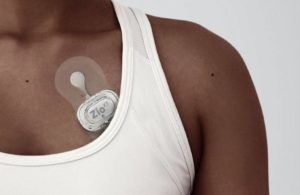
iRhythm Technologies (Nasdaq:IRTC) officials think their company’s wearable heart monitoring tech could serve millions more patients, tripling company revenue to more than $1 billion by 2027.
That was a big takeaway from the company’s 2022 Analyst & Investor Day news release today.
“Our technology platform is well suited to meet the needs of an evolving healthcare landscape while transforming a market that has not been disrupted in the last ten years,” said iRhythm CEO Quentin Blackford.
iRhythm today reaffirmed its 2022 guidance, predicting top-line growth of 29–30% to reach $415–420 million. Analysts polled on Yahoo! Finance predicted $418.64 million.
Investors appear to have been looking for more. IRTC shares were down more than 10% to $139.09 apiece in morning trading. MassDevice‘s MedTech 100 Index, which includes stocks of the world’s largest medical device companies, was down more than 1%.
iRhythm is projecting a 20% compound annual growth rate over the next five years. Truist analysts said the predicted growth rate was relatively in-line with investor expectations.
“Top-line growth contemplates core U.S .growth as well as contribution from select international markets, but leaves upside optionality from new adjacent markets (asymptomatic, sleep apnea, HF) — both of which we think could be conservative,” said David Rescott, Richard Newitter, Samuel Brodovsky, and Lin Zhang at Truist.
iRhythm also expects to grow its adjusted EBITDA margin to roughly 15% by 2027. The growth would represent an 18.5 percentage points improvement from its mid-2022 annual guidance. Truist analysts thought there could also be an upside on the EBITDA projection.
More about iRhythm
With more than $322 million in revenue in its fiscal year ended Dec. 31, 2021, iRhythm came in 92nd in MassDevice and Medical Design & Outsourcing‘s 2022 Big 100 report on the largest medical device companies. Being a $1-billion-a-year company would have boosted into the 70s on the list.
Founded in 2008, the San Francisco–based company seeks to usurp the old-school Holter monitor for electrocardiograph monitoring and AFib detection. Competitors include Baxter’s BardyDx and AliveCor.
iRhythm’s Zio monitor is small, unobtrusive, and water-resistant — with a 14-day wear time on the left side of the chest. The wearable includes cloud-based data analytics and machine-learning capabilities for cardiac monitoring.
Future products and technology include the Zio Monitor, iRhythm’s new biosensor technology platform, and the clinically-integrated Zeus aystem for the Zio Watch that iRhythm has been working on with Google’s Verily. iRhythm officials think there is a great deal of potential in Zio providing early AFib detection. There are also efforts to leverage artificial intelligence and explore adjacent market opportunities.
“In the last 5 years, we have served more than 4 million patients and delivered compounded annual revenue growth of over 30%,” Blackford said. “Going forward, we see a clear growth path to $1 billion in revenue by 2027 supported by our core business in the U.S. and internationally.”